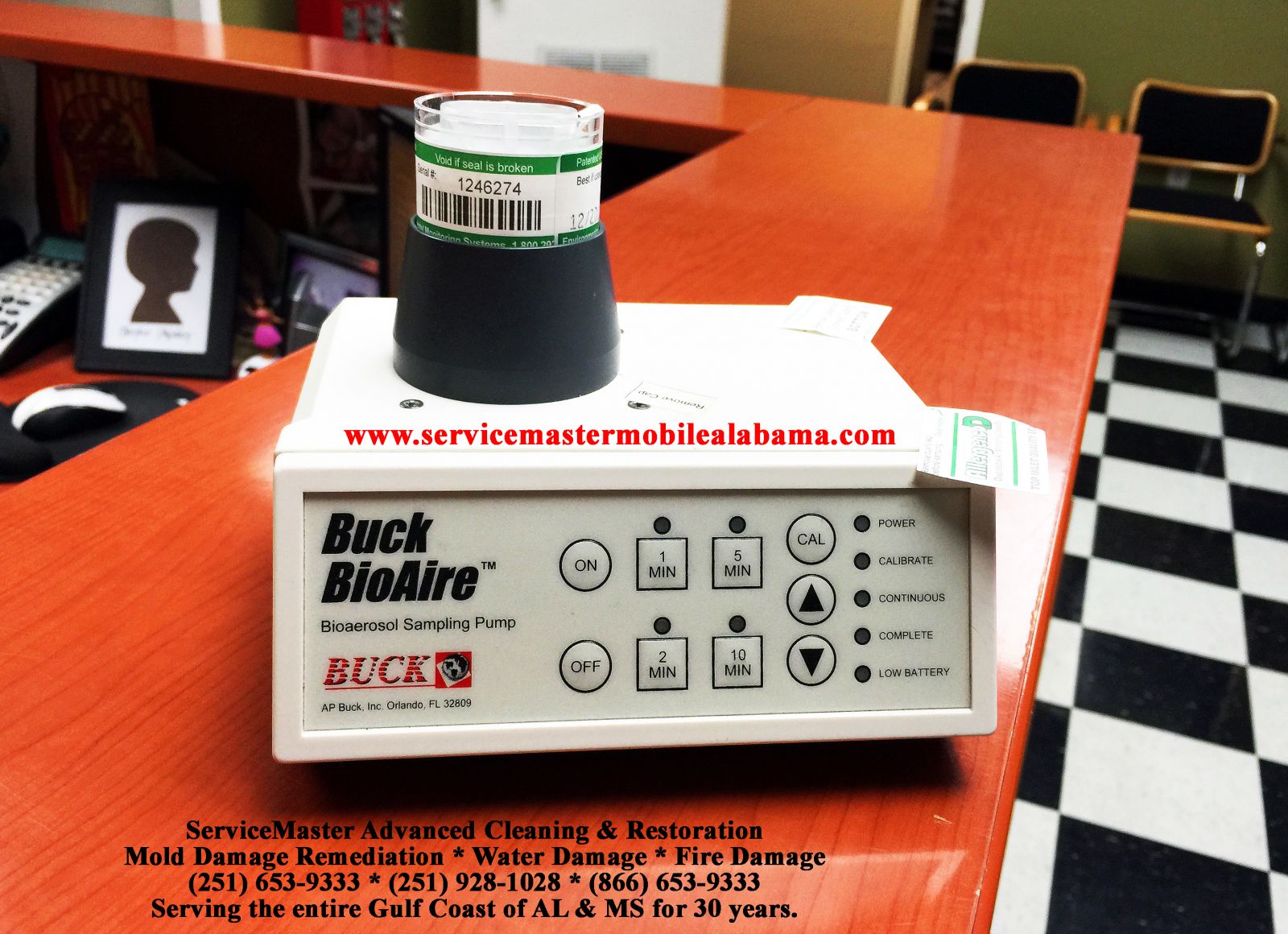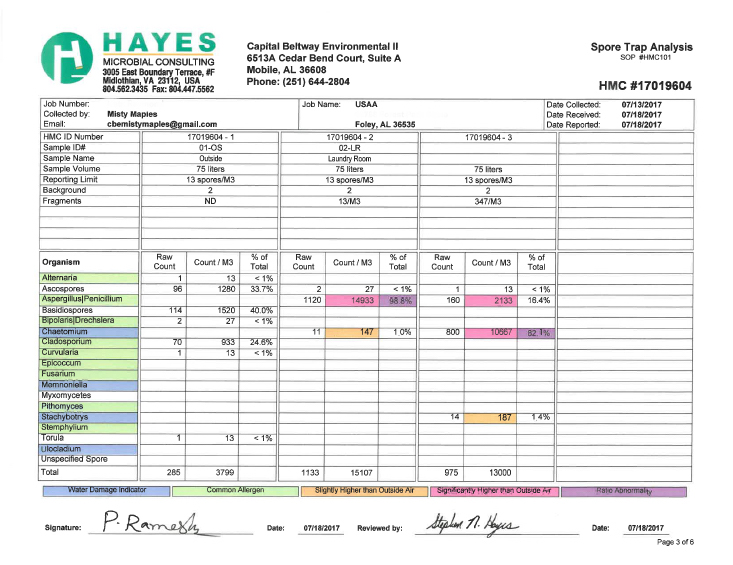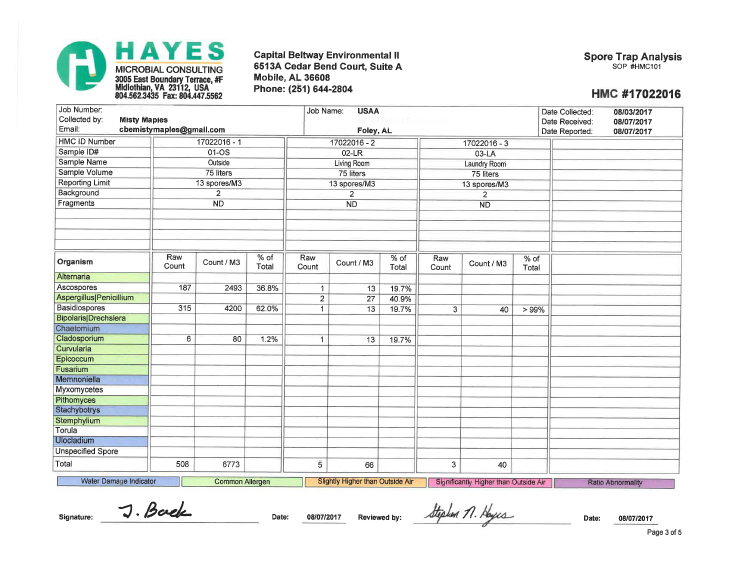ServiceMaster Advanced Cleaning & Restoration in Mobile, Baldwin County & the Mississippi Gulf Coast provides mold remediation services. We are called regularly to assist customers in mold evaluation and testing. Usually, we will recommend an Industrial hygeniest to do initial sample collection, analysis, write a protocol and do post-remediation testing. This ensures that the customer knows exactly what the contaminant is, how it is to be remediated, and finally, ensures that the structure is in fact, clear of all mold.
Typically, a bioaerosol sampling pump like the one below is used in air sample collection. 
The air samples are typically sent to a lab for analysis and a report like the one below is generated.

From this report a detailed protocol (written remediation instructions), is typically written up by the industrial hygienist. This protocol will contain specific instructions as to exactly what needs to be done including what drywall to remove, duct cleaning, and air scrubbing. The remediation company will follow this protocol and after completion, the IH will do post-remediation sampling. Another report will be generated from air samples.
Below is an example of a report that "passed" in terms of air quality.

At that point, the customer can be assured that the premises are fit to occupy.
Below is an article by Sanjay Gupta that gives some more detail on mold sampling and other methods used. We hope you find it informative.
Mold 101: Hazard Assessment, Measurements, and Identification!

CEO of 2 Int'l companies (RDMS & CFD) / Business Coach helping Entrepreneurs' unleash their true potential!
Article originally published on September 29th, 2015 at www.moldsensitized.com
MOLD 101: An Overview For Safety Professionals (Part 1)
In the last ten years, a body of scientific and anecdotal data has grown which points to interior mold contamination as a potentially serious health threat (for example see: ACGIH, Bioaerosols: Assessment and Control, AIHA, Report of Microbial Growth Task Force, EPA, A Guide for Mold Remediation in Schools and Commercial Buildings, Health Canada, Fungal Contamination in Public Buildings, IICRC, Standard and Reference Guide for Professional Water Damage Restoration, OSHA, Occupational Safety and Health Administration Technical Manual, NYCDH Guidelines on Assessment and Remediation of Fungi in Indoor Environments). In spite of this, many safety professionals do not concern themselves with mold contamination and indoor air quality (IAQ). Many safety professionals consider IAQ issues to be the business of industrial hygienists. However, there is an increasing amount of overlap between safety professionals and industrial hygienists on issues of mold contamination and remediation. Entry into confined spaces, formerly the exclusive domain of industrial hygienists, has been brought into the realm of safety professionals, and mold problems are poised to follow suit.
In light of the growing concern about mold contamination and health issues, safety professionals should be prepared to deal with these issues. This article was written to provide safety professionals with the basic understanding they will need to answer those questions. However, please note that the information in this article is a simplification and compilation of information from several sources, meant to give a general overview of mold hazards and how to deal with them. The remediation industry is currently in a state of flux, and there are few true guidelines published. We have attempted to cull the best of the industry’s current standards in this article, but they may be subject to change as a consensus emerges.
Some Basic Information
In the common vernacular the terms mold and fungus are often used interchangeably. However, in the scientific community molds are just one of the categories of non-green plant-like organisms (along with mildew, mushrooms, yeast, rusts, and smuts) that fall under the heading of fungus. Since molds make up the largest component of the fungal classification with over 60,000 identified species, the two terms often are interchanged indiscriminately. Regardless of the type of fungal matter, they all share the characteristics of being able to grow without the benefit of sunlight. This means that the only things necessary for fungus to proliferate are a viable seed (known as a spore), a nutrient source, moisture, and the right temperature. This explains why fungal infestation is often found in damp, dark, and hidden spaces. Light and air circulation have a tendency to dry things out, making the area inhospitable for the fungus.
Another trait of all fungal types is that they can grow both through physical expansion as well as through the spread of spores, a process scientists term “sporation”. A good analogy for this dual method of growth would be to think of dandelions. If the conditions are right for such weeds to grow in a lawn, they have a tendency to spread to the point where they will crowd out the grass. If the heads are plucked off the dandelion plants, the weeds will spread locally by expanding the size and number of stems. If the conditions are more favorable, the dandelions will grow their characteristic yellow flowers that ultimately turn into seedpods. At that point, the wind’s physical action can transport the individual seeds great distances where they start new plants if they land in an appropriate place.
Most mold species act in a fashion similar to the dandelion. Once they get a foothold in a particular location rapid growth across the surface is possible if the moisture source is sufficient. This would be similar to the dandelion growing in size at the base during the spring rainy season. If the moisture source starts to decrease, many mold species will go into a sporation phase where they grow and release large numbers of microscopic spores into the air. Indeed, one researcher has estimated that a single round colony of penicillium mold 2.5 centimeters in diameter contains 400,000,000 spores, each spore so small that a microscope is needed to see it (Blewstone Press 42). In our analogy, the spores are the equivalent of light, fluffy dandelion seeds that so many children enjoy blowing off the stems, with the “stems” of mold referred to as hyphae. It is worth noting that certain analysis methods are able to identify hyphae as well as the individual mold spores.
The Prevalence of Fungus and Hazard Assessment
Many forms of fungus can be found throughout the natural world. People from the earliest of times have recognized not only the presence of fungus but have learned to distinguish between beneficial forms and harmful forms of these materials. The ancient Egyptians understood that the fungus called yeast was necessary if bread was to rise or beer and wine were to ferment. Many Asian nations have used dried black or green fungus for thousands of years as a seasoning for soups and sauces. There are types of mushrooms and truffles that have been known as delicacies since before the golden age of Greece. Blue cheese receives its characteristic marbling and taste from a mold. In the modern era, a common bread mold was manipulated to create the first class of disease-fighting antibiotics.
However, just as mankind learned early on how to identify the good fungi, the bad ones were known as well. The book of Leviticus in the Bible contains some of the earliest known instructions for the proper procedures to deal with mold growth on interior surfaces. Ancient Roman texts document the dangers of eating moldy grain. The great potato famine of 1845-1847 was a result of a fungus called “Late Blight” and led to an estimated 750,000 deaths. A more recent occurrence of serious fungal destruction was the death of thousands of people in the former Soviet Union in the 1940s due to their ingestion of grain that was contaminated with the mold Stachybotrys atra. This is the same mold that some doctors link to the death of infants in Cleveland, Ohio, and around the country. Stachybotryscan produce serious injury after ingestion or inhalation through internal poisoning which causes hemosiderosis, bleeding in the lungs.
Since mold, mushrooms and yeast can be beneficial or harmful it becomes crucial to have some understanding of the conditions that would result in a hazard due to a fungal contamination. In other words, if there’s a little bit of black mold in the corner of the shower stall, is it serious enough that people should run screaming from the building? What about a thick patch that covers half of a two foot by four foot ceiling tile and has gray spidery tentacles beginning to creep out of a black mass? Does it make a difference if these situations are in the crawlspace? The crawlspace of a factory versus the crawlspace of a school? Is the musty/mildew odor an indication of significant levels of contamination? What if you cannot find a visible source for the smell? While each situation of potential mold exposure has to be evaluated individually, there are several important items to consider in every case.
All visible interior sources of mold, or the characteristic musty/mold odors, should be investigated carefully. A small amount of visible mold or transient odors can often signal greater infestation that is hidden above ceiling tiles, below carpet, inside HVAC systems or between wall components. Such visible mold also is a sure sign of a moisture source. The investigation/hazard assessment should identify possible causes of structural or plumbing leaks, or reasons for elevated humidity levels (i.e., inadequate air conditioning capacity, spraying, mixing or cooking processes, unvented shower rooms, etc.).
The location of fungal contamination has a great impact on a hazard assessment. The most significant problems are cases where mold is in an air stream. Therefore, any mold contamination of an HVAC system, particularly the supply ductwork, needs to be addressed promptly. Mold in or near occupied spaces is the next priority. Even mold in less frequently entered areas, such as basements, crawlspaces, attics or service rooms, should be addressed as doors, floors, and walls usually do not create airtight barriers necessary to contain the microscopic spores.
The amount of mold also factors into a risk assessment. While any mold should be cleaned up, larger quantities may require the use of safety equipment to protect the workers and engineering controls to protect the building occupants. Many organizations suggest that patches of mold smaller than 2-3 square feet can be cleaned with minimal precautions (NYCDH Section 3.3). Contamination up to 30 square feet requires personal protective equipment and controlled activities (OSHA 6-9). Mold infestation greater than 30 square feet normally demands site specific engineering controls such as dust partitions, air filtering devices, special cleaners, and fungicides (EPA Table 2).
Although controversial, many mold remediation specialists treat certain species differently. Because of their ability to produce mycotoxins, molds such as Stachybotrysand Fusarium many times are approached from a more conservative standpoint—including the use of negative pressure enclosures for their removal.
Measurements and Identification
There are a number of ways to evaluate fungal contamination. Although there is a tendency in our society toward scientific precision and detailed quantification, the first step in evaluating the possible impact of mold contamination is to use three of our six senses (that’s right, six senses). Generally our visual sense, olfactory sense, and common sense are enough for us to distinguish between situations that are a nuisance (the mold in the shower stall) and a potential hazard (mold growing inside HVAC ductwork). A couple words of caution are necessary any time the discussion involves the use of physical senses or common sense as the first step of an investigation for potential fungal contamination. It is important to remember that there can be a large difference in the sense of smell from one person to the next. In general, women have a more acute sense of smell than men, and non-smokers than smokers. A second consideration is the fact that exposure to fungal contaminants, even at low levels, can sensitize some individuals so that they experience progressively greater symptoms even with decreasing exposure. Therefore, some people can experience symptoms when concentrations of spores in the air are low enough that no telltale musty or moldy smell is present.
The variability in human perception of airborne fungal contaminants is one of the reasons why testingcan be so important. Choosing the type of test you use, however, can be just as important as choosing to test. Whether it’s air samples or surface samples for possible fungal contamination you can choose between direct analysis samples and cultured samples.
Until a few years ago, especially for airborne samples, direct analysis samples were not well regarded. This was due primarily to sampling techniques that resulted in low collection efficiencies and the variability in collection media. With the advent of a commercially available cassette that standardized the collection medium and increased collection efficiency, the use of direct analysis sampling has grown tremendously. Many professionals in the IAQ field now use direct analysis samples as their initial screening tool because the results report both viable (i.e., spores that are capable of reproduction under the right conditions) and the non-viable spores. In addition to quantifying the spores in the air that can cause allergic reactions but might not grow because they are desiccated or have been altered in some fashion, the direct analysis system allows for the identification of hyphal fragments which helps determine if the spores are from an interior source. A faster turnaround time and simplified collection process are other reasons why the use of direct analysis samples has increased in popularity for investigations of possible fungal contamination.
If more detailed analysis of the fungal contamination is necessary, cultured samples are used. In this sampling technique, air is impacted against petri dishes with specific types of sampling media. These dishes are then incubated under controlled temperature and humidity conditions and the resulting growth visually examined. By its very design the cultured samples do not identify non-viable spores even though such material can also contribute to allergic reactions, but the technique does allow a more precise determination of fungal types (species and sub-species levels as compared to genus level for direct analysis samples). There is a built-in waiting time of 3 to 7 days while the samples grow in an incubation chamber.
Part two of this article will cover standards, guidelines, clean up, and control. Each week when our blogs are published we also notify our readers via e-mail, please subscribe to our mailing list to stay informed.
Remember that YOU AND YOU ALONE, decide who works in your home or business. YOU decide who handles your most precious of possessions! Tell your insurance provider WHEN YOU FILE YOUR CLAIM that you want SERVICEMASTER ADVANCED, Enterprise number 7027, or call us directly. Make sure that there is no confusion. There are other mitigation companies, and even others with similar sounding names. We are ServiceMaster Advanced, The Master of Disaster. "WE WOULD BE HONORED TO SERVE YOU." (251) 653-9333, (251) 928-1028, or (251) 943-2230. www.servicemastermobilealabama.com www.servicemasterbaldwincounty.com
